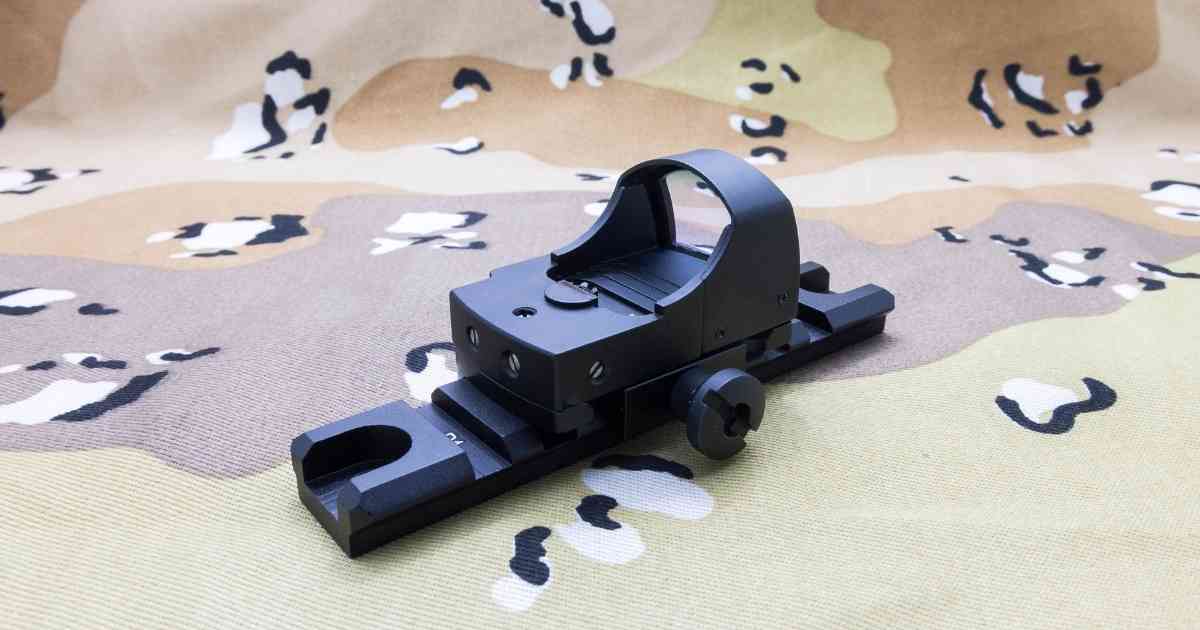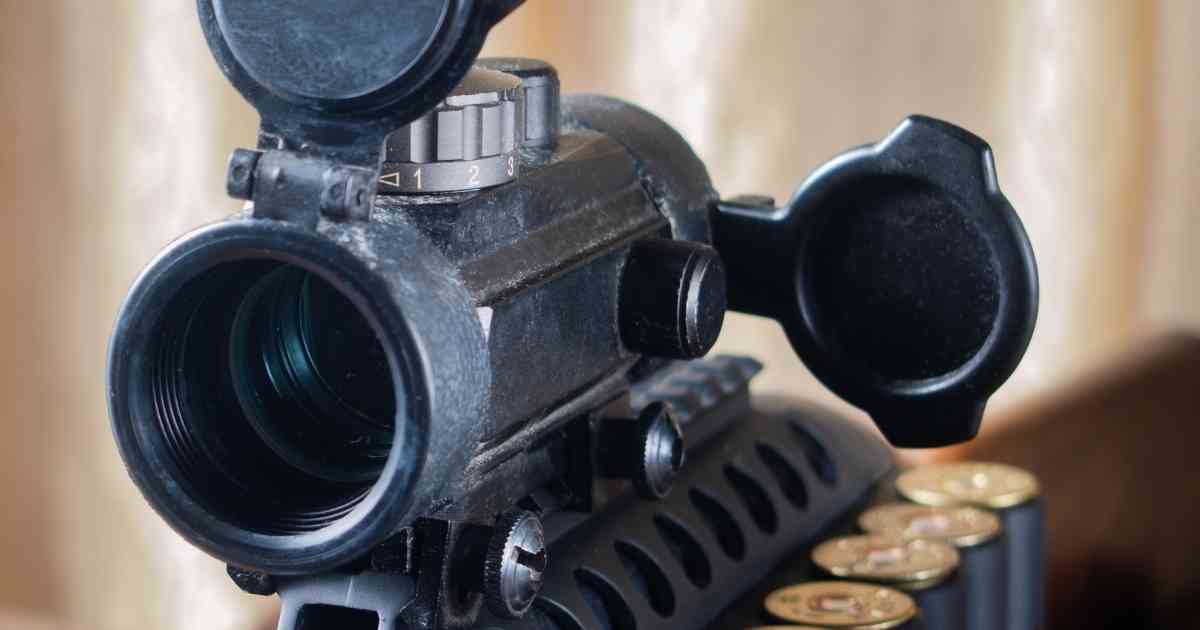Shooting is a fun hobby and sport that sends an explosion of sensation throughout your body. To make the activity even better, you will need a simple, accurate, and prompt process. This is where a red dot scope comes into focus.
One of the easiest ways to sight in a red dot scope without shooting is by using a bore sighter. Bore sighting involves lining up the barrel’s center with the sights. Here, you will need to measure the exact distance between you and the target before shooting.
A red dot scope is an optical device that you can find and use with ease. This gadget improves a shooter’s precision by focusing on the field of view in front of them. You can only use this method for long ranges of about 100 yards with high accuracy. In this article, we will discuss how to sight a red dot scope without shooting.
Difference Between a Red Dot Scope and a Red Dot Sight?

Before differentiating between these two, first we need to define the concept of the “red dot”. A red dot optic helps you acquire a target using a red dot to help you shoot your gun accurately. A red dot scope and sight work similarly in helping you zero in on your target, you can magnify your view with a red dot scope, a feature missing in a red dot sight.
How Does a Red Dot Scope Work?
Light Emitting Diode (LED)
A red dot is usually radiated through a Light Emitting Diode (LED) on a glass plate. This LED keeps the red dot reticle aligned with your gun regardless of your eye location. The red dot contains a circular mirror that works to reflect the red LED.
When the light from the LED hits the mirror, it bounces back to the shooter’s eyes. This red dot scope will remain in the shooter’s eyes once you have zeroed in on the aiming point.
A simple red dot appears crisp and clean and does not need extra lenses or focus.
To use this red dot scope, aim it at your target before shooting. The more accurate your aim is, the sharper your shooting accuracy will be.
Laser Diode
A laser diode is a semiconductor device. The diode works by generating high-intensity and clear light. The laser diode uses the Light Amplification by Stimulated Emission of Radiation (LASER) to generate laser light.
Laser Diode sights will cost more money than the LED ones because you will need to add extra components. This ensures the aiming is crisp. When powered, the system will allow your laser diode to emit light that a mirror will reflect. This light will then hit a reflector that is usually found behind the lenses and roof of the sight.
This ensures that the light reflects and travels in a straight line instead of spreading out. The light then bounces back again on the holographic grating, through the lens, to the shooter.
Types of Red Dot
Reflex Sights

Reflex sights are the most common type of red dot scopes. They function by using a small LED that projects a colored dot of light against a lens. The lens reflects the speck of light towards your eyes, which will allow you to see the red dot through the red dot sight.
These sights have an advantage because they are light, compact, and can mount on any rifle. But they do not function well in bad weather conditions.
Red dot scopes on reflex sights are usually larger than the other types of sights. They are best for situations when you need to have a small dot for tactical use. We recommend buying reflex sights for short ranges. This is because they are less sensitive to the eye’s position.
Prism Sights

Prism Sights work like traditional lens scopes, but they use a prism instead of lenses. The prism sights use a prism to focus the image and the light.
A reflective prism works by reflecting light. The prisms can flip, rotate, invert, or diverge a beam of light. Prism Sights are available with slight magnification. This allows for etched or illuminated reticles.
We recommend these for average distances because their magnification can improve long-range precision.
Holographic Sights

Also known as Holographic Diffraction Sights, Holographic sights are weapon optics. They include lasers and mirrors that send the image of a reticle back to the shooter’s eyes.
These sights are better than the other sights because they focus on your target faster. While other sights focus the dot to your eyes, these project the reticle in front of the sight.
They are also durable and can withstand extreme weather environments.
Bore Sighting
Bore Sighting involves aligning the center of a gun’s barrel (bore) with the sights on your firearm. This process is usually simple and essential to amateur and seasoned shooters.
A bore sighting tool aids in perfecting your target’s aim without needing to shoot. The problem is that bore sighting will not be as accurate as when you’re sighting using a rifle unless you’re shooting somewhere close. You need to secure your gun and ensure it sits still to line up your laser beam to the target.
If you want to shoot a target about 50-100 yards away then any slight difference in the way the laser fits into the chamber or barrel might cause a change in your bullet’s trajectory.
Types of Bore Sighting
There are three types of bore sighting tools. These include visual bore sighting, laser bore sighting, and optical bore sighting.
Visual Bore Sighting
Visual Bore sighting is a conventional technique that is quite simple. Here, you proceed by removing the bolt from the rifle before proceeding.
It entails lining up the center of the firearm’s barrel with the sights. You can choose to point the rifle on a steady platform. Fine-tune the knobs while looking through the bore to line it up.
You can also use the mirror method. This method uses a mirror that you place at a distance so you can see your reflection. Make sure to point the rifle with a straight barrel within the gun’s reflection. Then twist it to align it with the weapon’s barrel.
Laser Bore sighting
This type of bore sighting is usually high-tech and bullet-shaped. The size is usually determined by the gun you are shooting with. A laser bore sight is generally mounted on the firearm’s barrel inside the muzzle like ammo. You will then look inside the barrel to spot the red dot.
Control the dot with your eye to ensure it centres with the target highlighted. This method gives you a faster, easier, and more precise shooting experience. Continue rotating the scope’s crosshairs until the red dot aligns with the target.
To achieve this, you will need to adjust the knobs, which are the scope, to align everything. This will ensure that the red dot is at the centre of the laser and your gun zeroes in on the target.
Optical Bore Sighting
This method is more complicated than the Laser Bore Sight but works the same way. An Optical Bore sighter is usually mounted to the end of your weapon’s barrel. After aligning the optical, line up the lens on your gun to the scope.
Proceed by focusing on the red dot to line up with the grid displayed through the scope. Ensure you rotate the crosshairs to achieve a central point on the red dot. Remove the optical boresight once done and shoot away!
How to Sight in a Red Dot Scope without Shooting
Before starting this activity, you should know the process of sighting a red dot scope. If you are a new shooter, we recommend some initial training steps. Before jumping in, you should learn how to choose a rifle, balance and align it. You also need to align your gun and practice with a weapon and a dot.
1. Measure the distance between you and your target
This will help you balance and align to ensure your target is well placed. The minimum range for an experienced shooter is 100 yards. In comparison, a rifleman can go up to 250 yards. New shooters can shoot at a 20-25 yards range.
2. Tools and equipment
After measuring your distance, collect the equipment needed for the shoot. Ensure that you follow all necessary precautions to avoid injuries and accidents. Choose an open place for practice. Ensure that your gun is not loaded at this stage.
To sight in a red dot scope without shooting, you will need your gun and red dot installed on it. You will also need a powerful laser pointer at the end of your barrel, or into the chamber depending on your gun.
Remember that the boresight should match your rifle’s diameter. This will approximate your shot’s point of impact.
3. Mounting the Scope
Insert the bore sight into the rifle. Confirm that your setup is stable while mounting. The scope should be on top of the receiver and tightened to minimize movements. Cheaper bore sights cannot tighten up or fit well. So it is important to choose high-quality sights. These sights will cost a little bit more.
4. Check your target
- Depending on your choice, you can zero in at 25 yards or 50 yards. Ensure that your target is set. Deciding the distance is essential as your red dot will only be precise at a distance you zero.
- At this step, your bore sight might not have a lot of battery because it ensures daylight visibility.
- Get your rifle on aim while using the laser, while ignoring the red dot sight first.
- Once you adjust the laser to the center of the target, secure the rifle without holding it.
- Use the windage and elevation adjustments to move the reticle to lay on top of the laser.
- Once complete, you can zero into 25 or 50 yards, though we recommend first bore the rifle at 25 yards and then at 50.
5. Take Your Shot
After you complete the preparation steps, take a shot at your target. Start with at least 3-5 shots depending on your grouping.
Check the centering of the groupings. Measure the distance from the center point to where aiming. Adjust the red dot and repeat the shooting.
Benefits of Red Dot Scoping
- Red dot scopes assure you of close-range accuracy. It is easier to target in close-range situations than with magnification. This scoping method is accurate and easy to operate.
- Red dot sights do not need an intermediary to assist you. This will give you the headspace to focus on your shot instead of lining everything up.
- The red dot appears larger at a higher setting than on a lower one. This gives you Multiple Minutes of Angle (MOA) options. These options allow you to adjust depending on your preference and distance.
- The red dot ensures you zero in on the target in less time. This will give you, the shooter, the confidence you need to shoot faster.
- A red dot is easier to sight in the darkness.
- Allows you to shoot with both of your eyes open.
Disadvantages of Red Dot Scoping
- Red dot sightings are battery-operated and consume more energy in daylight. They will need a lot of power for visibility. This is a setback, especially if the battery shuts down during a shooting session.
- While it may guarantee accuracy within close ranges, it may not help with long distances. Red dots allow the shooter to shoot with both eyes open. This ensures maximum situational awareness.
Final Thoughts
Shooting is the best way for you to feel an adrenaline rush but still maintain concentration and accuracy. In this article, we discussed how to sight in a red dot scope without shooting. We also touched on the benefits and drawbacks of using this technique.
We hope you successfully learned the types of bore sightings. Red Dot Sighting is the best way to save you your ammo and give you near-perfect precision. The secret is getting a high-quality boresight and ensuring you’re accurate when sighting.
